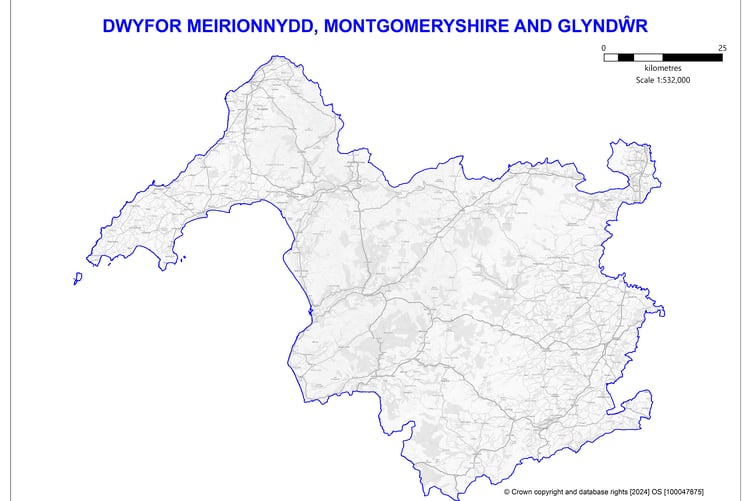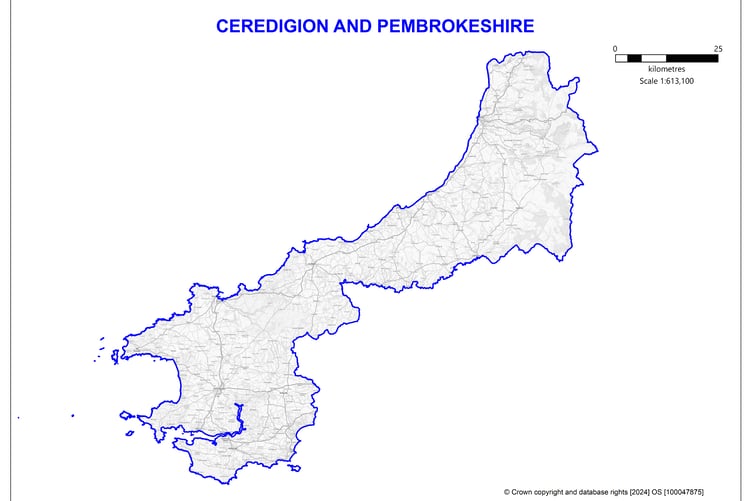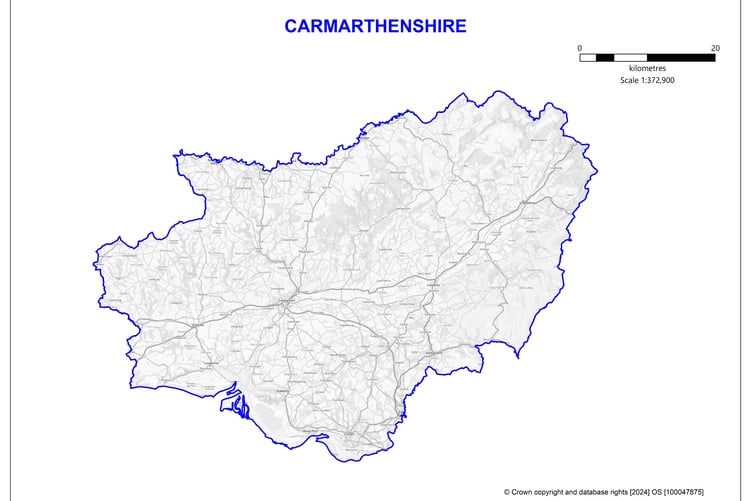PLANS to scrap first-past-the-post elections in Wales and have voters choose a party and not a candidate in new super-constituencies have been revealed.
In 2026, the Senedd will expand from 60 to 96 members and adopt a new electoral system, with the 32 constituencies used in July’s Westminster general election paired to create 16.
Ceredigion is set to be paired with Pembrokeshire in new look constituencies for the 2026 Senedd elections, with Dwyfor Meirionnydd joining Montgomeryshire and Glyndŵr into a single new seat – stretching from the Irish Sea to the England border.
The largest boundary being proposed is 1,927 sq miles (4,992 sq km).
The Democracy and Boundary Commission Cymru has published Initial Proposals for Wales’ new Senedd constituencies which will see the creation of 16 constituencies to replace the current 40 constituencies and 5 regions.

These new constituencies will take effect automatically at the 2026 Senedd election, and six MSs will be elected from each one, using the D’Hondt method currently used for the Senedd’s regional lists.
This means voters will not get to choose a specific candidate, but will instead have to vote for a party.
The Commission has had to create 16 constituencies by pairing Wales’ 32 UK parliamentary constituencies, ensuring that each constituency neighbours the one with which it is paired.
The Commission considers that constituencies should only be thought of as “contiguous” or neighbouring if it is possible to travel throughout it without having to leave the constituency.
Chief Executive of the Democracy and Boundary Commission Cymru, Shereen Williams MBE OStJ said: “Today marks a very important step in the journey towards reforming the Senedd.
“At the 2026 Senedd election, our national parliament will be elected using an entirely new system, with entirely new constituencies.

“The Commission is confident that our initial proposals represent a very good first step in creating Wales’ 16 new Senedd constituencies, but we know from experience that these processes are always strengthened when we hear from the public.
“So we strongly encourage everyone to share their views with us, whether they support or oppose the proposals, so that we can go on to further strengthen the map ahead of the next election.”
The initial consultation period closes on 30 September, and the Commission will publish its Revised Proposals report in December 2024.
Another four-week consultation period will then follow with a final decision expected in March 2025.
The boundary commission has proposed the following constituencies which would each be represented by six Senedd members:
• Bangor Aberconwy Ynys Môn
• Clwyd
• Alyn, Deeside and Wrexham
• Dwyfor Meirionnydd, Montgomeryshire and Glyndŵr
• Ceredigion and Pembrokeshire
• Carmarthenshire
• Swansea West and Gower
• Brecon, Radnor, Neath and Swansea East
• Aberafan Maesteg, Rhondda and Ogmore
• Merthyr Tydfil, Aberdare and Pontypridd
• Blaenau Gwent, Rhymney and Caerphilly
• Monmouthshire and Torfaen
• Newport and Islwyn
• Cardiff East and North
• Cardiff West, South and Penarth
• Vale of Glamorgan and Bridgend
Dwyfor Meirionnydd, Montgomeryshire and Glyndŵr would stretch from the coast to the border, with the commission
In the full 51-page report, the commission sets out the criteria for the 2026 boundary review, including local ties, shared history, the Welsh language and socio-economic considerations.
Ynys Môn and Dwyfor Meirionnydd, for example, was not considered viable because it is not possible to travel by road from one to the other without entering Bangor Aberconwy.
A four-week consultation has opened seeking people’s views on the initial proposals, with suggestions for different pairings and constituency names welcomed.

Following the initial consultation, which ends on September 30, the independent commission will publish revised proposals in December.
Then a second four-week consultation will follow in January, with a final decision expected to be published in March 2025 ahead of the next Senedd election in May 2026.
A further review will be held after the election, with the commission given more leeway to formulate constituencies which could vary in number of voters by as much as 20%.’
Shereen Williams, chief executive of the Democracy and Boundary Commission Cymru, said: “The commission is confident our initial proposals represent a very good first step….
“But we know from experience that these processes are always strengthened when we hear from the public.
“So we strongly encourage everyone to share their views with us, whether they support or oppose the proposals, so we can further strengthen the map ahead of the next election.”
Speaking on the Hiraeth podcast about Welsh politics, Ms Williams described the review as a jigsaw, with the commission tasked with ensuring all the pieces fit and make sense.
She cautioned: “You can’t get a perfect map of constituency boundaries across the country.”
Readers can have their say on the proposals by visiting the commission’s website, emailing [email protected] or by post to DBCC, Cathays Park, Cardiff CF10 3NQ.
Darren Millar, the Conservatives’ shadow constitution minister, reiterated his party’s opposition to Senedd expansion, describing electoral reform as the wrong priority.
He said: “More boundary changes will cause further upheaval and confusion for those who have already had to contend with boundary changes in council and Westminster elections.
“We need a Welsh Government that is focused on getting to grips with problems in our NHS, education system and economy – not one that is obsessed with more politicians and constitutional change.”
Mike Hedges, who represents Swansea East, was surprised to see Neath and Swansea East paired with Brecon, Radnor and Cwm Tawe rather than Aberafan Maesteg.
The Labour backbencher raised concerns about the size of the proposed new Brecon, Radnor, Neath and Swansea East constituency.
Mr Hedges said: “It will be a very big constituency from St Thomas Swansea to Presteigne in Radnorshire – over 80 miles and over two hours’ driving.”
Plaid Cymru described the reforms as a long-overdue move to strengthen Welsh democracy.
The party said: “From 2026, the people of Wales will be better represented and the Welsh Government can be more effectively scrutinised
“We look forward to engaging with the commission to ensure new Senedd constituencies take full account of … geographic, historical, and linguistic considerations.”
The Welsh Government welcomed the initial report as an important first step in the public consultation and stressed it has no role in the independent boundary review process.
A spokesperson said: “We encourage interested parties to engage to help shape the new Senedd electoral constituencies.”
When the final report is published, ministers will be required to bring forward regulations and will not be able to deviate from the recommendations which will not need Senedd approval.
Why are Senedd boundaries being reviewed?
The boundary review forms part of wider reforms to Senedd elections.
Under the Senedd Cymru (Members and Elections) Act, which was passed in May, a new electoral system will be introduced from 2026, meaning boundaries need to be redrawn.
Proponents of the reforms argue a bigger, more proportional Senedd will make it a more effective parliament, better able to hold the Welsh Government to account.
Meanwhile, those opposed point to the estimated £18m-a-year cost of expanding the Senedd, arguing resources would be better spent on schools and hospitals.
Ultimately, the reforms are happening due to the current parliamentary arithmetic which provides a potentially once-in-a-generation opportunity.
A supermajority was needed to pass the law. Labour and Plaid Cymru did not have the numbers in the five years to 2021 and polls suggest they may fall short of two-thirds in 2026.
Currently, Wales uses an additional member system – a mix of proportional representation and the first-past-the-post system used in Westminster elections.
Forty constituency Senedd members are elected via first past the post and a further 20 are elected to represent five regions via party lists.
But from 2026 voters will receive one ballot rather than two, with first past the post scrapped and all members elected via a full form of proportional representation.
Wales will use “closed lists”, which will see people voting for parties rather than specific candidates, despite experts describing the new system as dangerous.
Political parties will decide the order of candidates on lists unlike under a flexible-list system or the single transferable vote which would give the electorate a say.
The D’Hondt method, a formula to apportion seats based on votes, will continue to be used over the Sainte-Laguë system which would benefit smaller parties.
The map and plan to elect more politicians was originally penned by former first minister Mark Drakeford and ex-Plaid Cymru leader Adam Price.
Voters will only be able to back a party, rather than a specific candidate - and there are concerns that will break the link between the electorate and the politicians themselves.
The closed list element of the reform has however been heavily criticised by leading academic, Professor Laura McCallister, who says it is a 'major weakness' because 'it removes the choice from electors to choose individual candidates'.
The closed lists system is said to have been designed to make the Welsh Parliament more proportional, giving voters choice between parties instead of individuals.
Candidates are then elected from a list of names selected and ranked by each party.
Professor McCallister said: "It seems odd to me that at a time when there's such a disconnect between the politicians and the public, we're disconnecting it further.
"The risk... is that they will reward loyalty and longevity rather than calibre and challenge.
"I think that won't help the diversity of the class of politicians we get, and I think the public will very quickly get aggrieved when they realise they won't be able to select a politician that they wish to."
She added that closed lists would put too much power in the hands of parties, and could erode trust with the public.
.png?trim=0,2,0,1&width=752&height=501&crop=752:501)

.png?width=209&height=140&crop=209:145,smart&quality=75)


Comments
This article has no comments yet. Be the first to leave a comment.